Although adapted and updated, much of the information in this lecture is derived from C. David Mortensen, Communication: The Study of Human Communication (New York: McGraw-Hill Book Co., 1972), Chapter 2, “Communication Models.”
A. What is a Model?
1. Mortensen: “In the broadest sense, a model is a systematic representation of an object or event in idealized and abstract form. Models are somewhat arbitrary by their nature. The act of abstracting eliminates certain details to focus on essential factors. . . . The key to the usefulness of a model is the degree to which it conforms--in point-by-point correspondence--to the underlying determinants of communicative behavior.”
2. “Communication models are merely pictures; they’re even distorting pictures, because they stop or freeze an essentially dynamic interactive or transactive process into a static picture.”
3. Models are metaphors. They allow us to see one thing in terms of another.
B. The Advantages of Models
1. They should allow us to ask questions.
Mortensen: “A good model is useful, then, in providing both general perspective and particular vantage points from which to ask questions and to interpret the raw stuff of observation. The more complex the subject matter—the more amorphous and elusive the natural boundaries—the greater are the potential rewards of model building.”
2. They should clarify complexity.
Models also clarify the structure of complex events. They do this, as Chapanis (1961) noted, by reducing complexity to simpler, more familiar terms. . . Thus, the aim of a model is not to ignore complexity or to explain it away, but rather to give it order and coherence.
3. They should lead us to new discoveries-most important, according to Mortensen.
At another level models have heuristic value; that is, they provide new ways to conceive of hypothetical ideas and relationships. This may well be their most important function. With the aid of a good model, suddenly we are jarred from conventional modes of thought. . . . Ideally, any model, even when studied casually, should offer new insights and culminate in what can only be described as an “Aha!” experience.
C. Limitations of Models
1. Can lead to oversimplifications.
“There is no denying that much of the work in designing communication models illustrates the oft-repeated charge that anything in human affairs which can be modeled is by definition too superficial to be given serious consideration.”
Some, like Duhem’s (1954), believe there is no value in models at all:
We can guard against the risks of oversimplification by recognizing the fundamental distinction between simplification and oversimplification. By definition, and of necessity, models simplify. So do all comparisons. As Kaplan (1964) noted, “Science always simplifies; its aim is not to reproduce the reality in all its complexity, but only to formulate what is essential for understanding, prediction, or control. That a model is simpler than the subject-matter being inquired into is as much a virtue as a fault, and is, in any case, inevitable [p. 280].” So the real question is what gets simplified. Insofar as a model ignores crucial variables and recurrent relationships, it is open to the charge of oversimplification. If the essential attributes or particulars of the event are included, the model is to be credited with the virtue of parsimony, which insists-where everything is equal-that the simplest of two interpretations is superior. Simplification, after all, is inherent in the act of abstracting. For example, an ordinary orange has a vast number of potential attributes; it is necessary to consider only a few when one decides to eat an orange, but many more must be taken into account when one wants to capture the essence of an orange in a prize-winning photograph. abstracting. For example, an ordinary orange has a vast number of potential attributes; it is necessary to consider only a few when one decides to eat an orange, but many more must be taken into account when one wants to capture the essence of an orange in a prize-winning photograph.
Models can miss important points of comparison. Chapanis (1961), “A model can tolerate a considerable amount of slop [p. 118].”
2. Can lead of a confusion of the model between the behavior it portrays
Mortensen: “Critics also charge that models are readily confused with reality. The problem typically begins with an initial exploration of some unknown territory. . . .Then the model begins to function as a substitute for the event: in short, the map is taken literally. And what is worse, another form of ambiguity is substituted for the uncertainty the map was designed to minimize. What has happened is a sophisticated version of the general semanticist’s admonition that “the map is not the territory.” Spain Minnesota United States
“The proper antidote lies in acquiring skill in the art of map reading.”
3. Premature Closure
The model designer may escape the risks of oversimplification and map reading and still fall prey to dangers inherent in abstraction. To press for closure is to strive for a sense of completion in a system.
Kaplan (1964):
The danger is that the model limits our awareness of unexplored possibilities of conceptualization. We tinker with the model when we might be better occupied with the subject-matter itself. In many areas of human behavior, our knowledge is on the level of folk wisdom ... incorporating it in a model does not automatically give such knowledge scientific status. The majority of our ideas is usually a matter of slow growth, which cannot be forced.... Closure is premature if it lays down the lines for our thinking to follow when we do not know enough to say even whether one direction or another is the more promising. Building a model, in short, may crystallize our thoughts at a stage when they are better left in solution, to allow new compounds to precipitate [p. 279].
One can reduce the hazards only by recognizing that physical reality can be represented in any number of ways.
D. Classical Communication Models
1. Aristotle’s definition of rhetoric. Ehninger, Gronbeck and Monroe
a. “Rhetoric” is “the faculty of observing in any given case the available means of persuasion” (Rhetoric 1335b).
b. Aristotle’s speaker-centered model received perhaps its fullest development in the hands of Roman educator Quintilian (ca. 35-95 A.D.), whose Institutio Oratoria was filled with advice on the full training of a “good” speaker-statesman.
2. Aristotle’s model of proof. Kinnevay also sees a model of communication in Aristotle’s description of proof:
a. Logos, inheres in the content or the message itself
b. Pathos, inheres in the audience
c. Ethos, inheres in the speaker
3. Bitzer’s Rhetorical Situation. Lloyd Bitzer developed described the “Rhetorical Situation,” which, while not a model, identifies some of the classical components of a communication situation (“The Rhetorical Situation,” Philosophy and Rhetoric, 1 (Winter, 1968):1-15.).
Bitzer defines the “rhetorical situation” as “a complex of persons, events, objects, and relations presenting an actual or potential exigence which can be completely or partially removed if discourse, introduced into the situation, can so constrain human decision or action so as to bring about significant modification of the exigence.”
E. Early Linear Models
1. The Shannon-Weaver Mathematical Model, 1949
a. Background
i. Claude Shannon, an engineer for the Bell Telephone Company, designed the most influential of all early communication models. His goal was to formulate a theory to guide the efforts of engineers in finding the most efficient way of transmitting electrical signals from one location to another (Shannon and Weaver, 1949). Later Shannon introduced a mechanism in the receiver which corrected for differences between the transmitted and received signal; this monitoring or correcting mechanism was the forerunner of the now widely used concept of feedback (information which a communicator gains from others in response to his own verbal behavior).
b. Strengths
i. This model, or a variation on it, is the most common communication model used in low-level communication texts.
ii. Significant development. “Within a decade a host of other disciplines—many in the behavioral sciences—adapted it to countless interpersonal situations, often distorting it or making exaggerated claims for its use.”
iii. “Taken as an approximation of the process of human communication.”
iv. Significant heuristic value.
1.) With only slight changes in terminology, a number of nonmathematical schemas have elaborated on the major theme. For example, Harold Lasswell (1948) conceived of analyzing the mass media in five stages: “Who?” “Says what?” “In which channel?” “To whom?” “With what effect?” In apparent elaboration on Lasswell and/or Shannon and Weaver, George Gerbner (1956) extended the components to include the notions of perception, reactions to a situation, and message context.
v. The concepts of this model became staples in communication research
1.) Entropy-the measure of uncertainty in a system. “Uncertainty or entropy increases in exact proportion to the number of messages from which the source has to choose. In the simple matter of flipping a coin, entropy is low because the destination knows the probability of a coin’s turning up either heads or tails. In the case of a two-headed coin, there can be neither any freedom of choice nor any reduction in uncertainty so long as the destination knows exactly what the outcome must be. In other words, the value of a specific bit of information depends on the probability that it will occur. In general, the informative value of an item in a message decreases in exact proportion to the likelihood of its occurrence.”
2.) Redundancy-the degree to which information is not unique in the system. “Those items in a message that add no new information are redundant. Perfect redundancy is equal to total repetition and is found in pure form only in machines. In human beings, the very act of repetition changes, in some minute way, the meaning or the message and the larger social significance of the event. Zero redundancy creates sheer unpredictability, for there is no way of knowing what items in a sequence will come next. As a rule, no message can reach maximum efficiency unless it contains a balance between the unexpected and the predictable, between what the receiver must have underscored to acquire understanding and what can be deleted as extraneous.”
3.) Noise-the measure of information not related to the message. “Any additional signal that interferes with the reception of information is noise. In electrical apparatus noise comes only from within the system, whereas in human activity it may occur quite apart from the act of transmission and reception. Interference may result, for example, from background noise in the immediate surroundings, from noisy channels (a crackling microphone), from the organization and semantic aspects of the message (syntactical and semantical noise), or from psychological interference with encoding and decoding. Noise need not be considered a detriment unless it produces a significant interference with the reception of the message. Even when the disturbance is substantial, the strength of the signal or the rate of redundancy may be increased to restore efficiency.”
4.) Channel Capacity-the measure of the maximum amount of information a channel can carry. “The battle against uncertainty depends upon the number of alternative possibilities the message eliminates. Suppose you wanted to know where a given checker was located on a checkerboard. If you start by asking if it is located in the first black square at the extreme left of the second row from the top and find the answer to be no, sixty-three possibilities remain-a high level of uncertainty. On the other hand, if you first ask whether it falls on any square at the top half of the board, the alternative will be reduced by half regardless of the answer. By following the first strategy it could be necessary to ask up to sixty-three questions (inefficient indeed!); but by consistently halving the remaining possibilities, you will obtain the right answer in no more than six tries.”
vi. Provided an influential yet counter-intuitive definition of communication.
From Littlejohn, Stephen W. Theories of Human Communication. Second Ed. Belmont, California: Wadsworth, 1983, p 116.
Information is a measure of uncertainty, or entropy, in a situation. The greater the uncertainty, the more the information. When a situation is completely predictable, no information is present. Most people associate information with certainty or knowledge; consequently, this definition from information theory can be confusing. As used by the information theorist, the concept does not refer to a message, facts, or meaning. It is a concept bound only to the quantification of stimuli or signals in a situation.
On closer examination, this idea of information is not as distant from common sense as it first appears. We have said that information is the amount of uncertainty in the situation. Another way of thinking of it is to consider information as the number of messages required to completely reduce the uncertainty in the situation. For example, your friend is about to flip a coin. Will it land heads up or tails up? You are uncertain, you cannot predict. This uncertainty, which results from the entropy in the situation, will be eliminated by seeing the result of the flip. Now let’s suppose that you have received a tip that your friend’s coin is two headed. The flip is “fixed.” There is no uncertainty and therefore no information. In other words, you could not receive any message that would make you predict any better than you already have. In short, a situation with which you are completely familiar has no information for you [emphasis added].
vii. See Claude Shannon and Warren Weaver, The Mathematical Theory of Communication (Urbana: University of Illinois Press, 1949). For a number of excellent brief secondary sources, see the bibliography. Two sources were particularly helpful in the preparation of this chapter: Allan R. Broadhurst and Donald K. Darnell, “An Introduction to Cybernetics and Information Theory,” Quarterly Journal of Speech 51 (1965): 442-53; Klaus Krippendorf, “Information Theory,” in Communication and Behavior, ed. G. Hanneman and W. McEwen (Reading, Mass.: Addison-Wesley, 1975), 351-89.
c. Weaknesses
i. Not analogous to much of human communication.
1.) “Only a fraction of the information conveyed in interpersonal encounters can be taken as remotely corresponding to the teletype action of statistically rare or redundant signals.”
2.) “Though Shannon ’s technical concept of information is fascinating in many respects, it ranks among the least important ways of conceiving of what we recognize as “information.” “
ii. Only formal—does not account for content
1.) Mortensen: “Shannon and Weaver were concerned only with technical problems associated with the selection and arrangement of discrete units of information—in short, with purely formal matters, not content. Hence, their model does not apply to semantic or pragmatic dimensions of language. “
2.) Theodore Roszak provides a thoughtful critique of Shannon ’s model in The Cult of Information. Roszak notes the unique way in which Shannon defined information:
Once, when he was explaining his work to a group of prominent scientists who challenged his eccentric definition, he replied, “I think perhaps the word ‘information’ is causing more trouble . . . than it is worth, except that it is difficult to find another word that is anywhere near right. It should be kept solidly in mind that [information] is only a measure of the difficulty in transmitting the sequences produced by some information source” [emphasis added]
3.) As Roszak points out, Shannon ’s model has no mechanism for distinguishing important ideas from pure non-sense:
In much the same way, in its new technical sense, information has come to denote whatever can be coded for transmission through a channel that connects a source with a receiver, regardless of semantic content. For Shannon ’s purposes, all the following are “information”:
E = mc2
Jesus saves.
Thou shalt not kill.
I think, therefore I am.
Phillies 8, Dodgers 5
‘Twas brillig and the slithy roves did gyre and gimble in the wabe.
And indeed, these are no more or less meaningful than any string of haphazard bits (x!9#44jGH?566MRK) I might be willing to pay to have telexed across the continent.
As the mathematician Warren Weaver once put it, explaining “the strange way in which, in this theory, the word ‘information’ is used .... It is surprising but true that, from the present viewpoint, two messages, one heavily loaded with meaning and the other pure nonsense, can be equivalent as regards information” [emphasis added].
iii. Static and Linear
1.) Mortensen: “Finally, the most serious shortcoming of the Shannon-Weaver communication system is that it is relatively static and linear. It conceives of a linear and literal transmission of information from one location to another. The notion of linearity leads to misleading ideas when transferred to human conduct; some of the problems can best be underscored by studying several alternative models of communication.”
2. Berlo’s S-M-C-R, 1960
a. Background
i. Ehninger, Gronbeck and Monroe
ii. Essentially an adaptation of the Shannon-Weaver model.
b. Significant after World War II because:
i. The idea of “source” was flexible enough to include oral, written, electronic, or any other kind of “symbolic” generator-of-messages.
ii. “Message” was made the central element, stressing the transmission of ideas.
iii. The model recognized that receivers were important to communication, for they were the targets.
iv. The notions of “encoding” and “decoding” emphasized the problems we all have (psycho-linguistically) in translating our own thoughts into words or other symbols and in deciphering the words or symbols of others into terms we ourselves can understand.
c. Weaknesses:
i. Tends to stress the manipulation of the message—the encoding and decoding processes
ii. it implies that human communication is like machine communication, like signal-sending in telephone, television, computer, and radar systems.
iii. It even seems to stress that most problems in human communication can be solved by technical accuracy-by choosing the “right” symbols, preventing interference, and sending efficient messages.
iv. But even with the “right” symbols, people misunderstand each other. “Problems in “meaning” or “meaningfulness” often aren’t a matter of comprehension, but of reaction, of agreement, of shared concepts, beliefs, attitudes, values. To put the com- back into communication, we need a meaning-centered theory of communication.”
3. Schramm’s Interactive Model, 1954
a. Background
Wilbur Schramm (1954) was one of the first to alter the mathematical model of Shannon and Weaver. He conceived of decoding and encoding as activities maintained simultaneously by sender and receiver; he also made provisions for a two-way interchange of messages. Notice also the inclusion of an “interpreter” as an abstract representation of the problem of meaning.
(From Wilbur Schramm, “How Communication Works,” in The Process and Effects of Communication, ed. Wilbur Schramm (Urbana: University of Illinois Press, 1954), pp. 3-26):
b. Strengths
i. Schramm provided the additional notion of a “field of experience,” or the psychological frame of reference; this refers to the type of orientation or attitudes which interactants maintain toward each other.
ii. Included Feedback
1.) Communication is reciprocal, two-way, even though the feedback may be delayed.
a.) Some of these methods of communication are very direct, as when you talk in direct response to someone.
b.) Others are only moderately direct; you might squirm when a speaker drones on and on, wrinkle your nose and scratch your head when a message is too abstract, or shift your body position when you think it’s your turn to talk.
c.) Still other kinds of feedback are completely indirect.
2.) For example,
a.) politicians discover if they’re getting their message across by the number of votes cast on the first Tuesday in November;
b.) commercial sponsors examine sales figures to gauge their communicative effectiveness in ads;
c.) teachers measure their abilities to get the material across in a particular course by seeing how many students sign up for it the next term.
iii. Included Context
1.) A message may have different meanings, depending upon the specific context or setting.
2.) Shouting “Fire!” on a rifle range produces one set of reactions-reactions quite different from those produced in a crowded theater.
iv. Included Culture
1.) A message may have different meanings associated with it depending upon the culture or society. Communication systems, thus, operate within the confines of cultural rules and expectations to which we all have been educated.
v. Other model designers abstracted the dualistic aspects of communication as a series of “loops,” (Mysak, 1970), “speech cycles” (Johnson, 1953), “co-orientation” (Newcomb, 1953), and overlapping “psychological fields” (Fearing, 1953).
c. Weaknesses
i. Schramm’s model, while less linear, still accounts for only bilateral communication between two parties. The complex, multiple levels of communication between several sources is beyond this model.
F. Non-linear Models
1. Dance’s Helical Spiral, 1967
a. Background
i. Depicts communication as a dynamic process. Mortensen: “The helix represents the way communication evolves in an individual from his birth to the existing moment.”
ii. Dance: “At any and all times, the helix gives geometrical testimony to the concept that communication while moving forward is at the same moment coming back upon itself and being affected by its past behavior, for the coming curve of the helix is fundamentally affected by the curve from which it emerges. Yet, even though slowly, the helix can gradually free itself from its lower-level distortions. The communication process, like the helix, is constantly moving forward and yet is always to some degree dependent upon the past, which informs the present and the future. The helical communication model offers a flexible communication process” [p. 296].
b. Strengths
i. Mortensen: “As a heuristic device, the helix is interesting not so much for what it says as for what it permits to be said. Hence, it exemplifies a point made earlier: It is important to approach models in a spirit of speculation and intellectual play.”
ii. Chapanis (1961) called “sophisticated play:”
The helix implies that communication is continuous, unrepeatable, additive, and accumulative; that is, each phase of activity depends upon present forces at work as they are defined by all that has occurred before. All experience contributes to the shape of the unfolding moment; there is no break in the action, no fixed beginning, no pure redundancy, no closure. All communicative experience is the product of learned, nonrepeatable events which are defined in ways the organism develops to be self-consistent and socially meaningful. In short, the helix underscores the integrated aspects of all human communication as an evolving process that is always turned inward in ways that permit learning, growth, and discovery.
c. Weaknesses
i. May not be a model at all: too few variables.
Mortensen: “If judged against conventional scientific standards, the helix does not fare well as a model. Indeed, some would claim that it does not meet the requirements of a model at all. More specifically, it is not a systematic or formalized mode of representation. Neither does it formalize relationships or isolate key variables. It describes in the abstract but does not explicitly explain or make particular hypotheses testable.”
ii. Generates Questions, but leaves much unaswered.
Mortensen: “For example, does not the helix imply a false degree of continuity from one communicative situation to another? Do we necessarily perceive all encounters as actually occurring in an undifferentiated, unbroken sequence of events? Does an unbroken line not conflict with the human experience of discontinuity, intermittent periods, false starts, and so forth? Is all communication a matter of growth, upward and onward, in an ever-broadening range of encounters? If the helix represents continuous learning and growth, how can the same form also account for deterioration and decay? What about the forces of entropy, inertia, decay, and pathology? And does not the unbroken line of a helix tacitly ignore the qualitative distinctions that inevitably characterize different communicative events? Also, what about movements which we define as utterly wasted, forced, or contrived? Along similar lines, how can the idea of continuous, unbroken growth include events we consider meaningless, artificial, or unproductive? Countless other questions could be raised. And that is the point. The model brings problems of abstraction into the open. “rtificial, or unproductive? Countless other questions could be raised. And that is the point. The model brings problems of abstraction into the open. “
2. Westley and MacLean’s Conceptual Model, 1957
a. Background
i. Westley and MacLean realized that communication does not begin when one person starts to talk, but rather when a person responds selectively to his immediate physical surroundings.
ii. Each interactant responds to his sensory experience (X1 . . . ) by abstracting out certain objects of orientation (X1 . . . 3m). Some items are selected for further interpretation or coding (X’) and then are transmitted to another person, who may or may not be responding to the same objects of orientation (X,b),
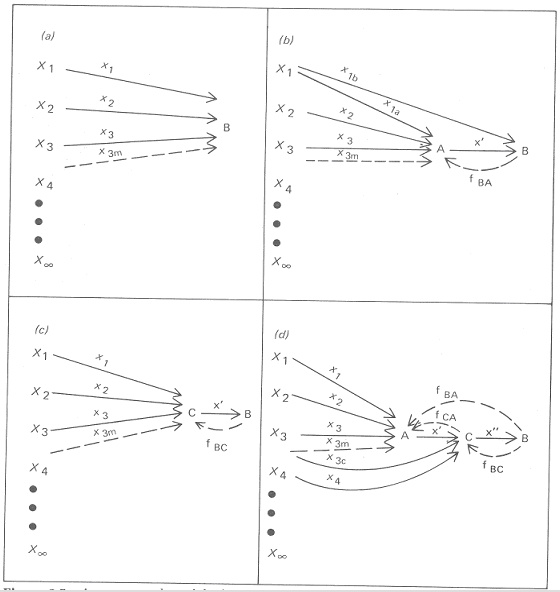 |
A conceptual model of communication. (Reprinted with permission from Westley and MacLean, Jr., 1957.) (a) Objects of orientation (X1 ... X) in the sensory field of the receiver (B) are transmitted directly to him in abstracted form (XZ ... X3) after a process of selection from among all Xs, such selection being based at least in part on the needs and problems of B. Some or all messages are transmitted in more than one sense (X3m, for example). (b) The same Xs are selected and abstracted by communicator A and transmitted as a message (x') to B, who may or may not have part or all of the Xs in his own sensory field (X1b). Whether on purpose or not, B transmits feedback (fBA) to A. (c) The Xs that B receives may result from selected abstractions which are transmitted without purpose by encoder C, who acts for B and thus extends B's environment. C's selections are necessarily based in part on feedback (fBC) from B. (d) The messages which C transmits to B (x") represent C's selections both from the messages he gets from A (x') and from the abstractions in his own sensory field (X3c, X4), which may or may not be in A's field. Feedback moves not only from B to A (fBA) and from B to C (fBC) but also from C to A (fCA). Clearly, in mass communication, a large number of Cs receive from a very large number of As and transmit to a vastly larger number of Bs, who simultaneously receive messages from other Cs. |
b. Strengths
i. Accounts for Feedback
ii. Accounts for a sensory field or, in Newcomb’s (1953) words, “objects of co-orientation.”
iii. Accounts for non-binary interactions—more than just two people communicating directly.
iv. Accounts for different modes. E.g. interpersonal vs. mass mediated communication.
c. Weaknesses
i. Westley and MacLean’s model accounts for many more variables in the typical communication interaction. It is, however, still two-dimensional. It cannot account for the multiple dimensions of the typical communication event involving a broad context and multiple message.
3. Becker’s Mosaic Model, 1968
a. Background
i. Mortensen: “Becker assumes that most communicative acts link message elements from more than one social situation. In the tracing of various elements of a message, it is clear that the items may result in part from a talk with an associate, from an obscure quotation read years before, from a recent TV commercial, and from numerous other dissimilar situations—moments of introspection, public debate, coffee-shop banter, daydreaming, and so on. In short, the elements that make up a message ordinarily occur in bits and pieces. Some items are separated by gaps in time, others by gaps in modes of presentation, in social situations, or in the number of persons present.”
ii. Mortensen: “Becker likens complex communicative events to the activity of a receiver who moves through a constantly changing cube or mosaic of information . The layers of the cube correspond to layers of information. Each section of the cube represents a potential source of information; note that some are blocked out in recognition that at any given point some bits of information are not available for use. Other layers correspond to potentially relevant sets of information.”
b. Strengths (from Mortensen)
i. It depicts the incredible complexity of communication as influenced by a constantly changing milieu.
ii. It also accounts for variations in exposure to messages. In some circumstances receivers may be flooded by relevant information; in others they may encounter only a few isolated items. Individual differences also influence level of exposure; some people seem to be attuned to a large range of information, while others miss or dismiss much as extraneous.
iii. Different kinds of relationships between people and messages cut through the many levels of exposure. Some relationships are confined to isolated situations, others to recurrent events. Moreover, some relationships center on a particular message, while others focus on more diffuse units; that is, they entail a complex set of relationships between a given message and the larger backdrop of information against which it is interpreted.
iv. It may be useful to conceive of an interaction between two mosaics. One comprises the information in a given social milieu, as depicted in the model; the other includes the private mosaic of information that is internal to the receiver. The internal mosaic is every bit as complex as the one shown in the model, but a person constructs it for himself.
c. Weaknesses
i. Even though this model adds a third dimension, it does not easily account for all the possible dimensions involved in a communication event.
G. Multidimensional Models
1. Ruesch and Bateson, Functional Model, 1951
a. Mortensen: “Ruesch and Bateson conceived of communication as functioning simultaneously at four levels of analysis. One is the basic intrapersonal process (level 1). The next (level 2) is interpersonal and focuses on the overlapping fields of experience of two interactants. Group interaction (level 3) comprises many people. And finally a cultural level (level 4) links large groups of people. Moreover, each level of activity consists of four communicative functions: evaluating, sending, receiving, and channeling. Notice how the model focuses less on the structural attributes of communication-source, message, receiver, etc.—and more upon the actual determinants of the process.”
b. Mortensen: “A similar concern with communicative functions can be traced through the models of Carroll (1955), Fearing (1953), Mysak (1970), Osgood (1954), and Peterson (1958). Peterson’s model is one of the few to integrate the physiological and psychological functions at work in all interpersonal events.”
2. Barnlund’s Transactional Model, 1970
a. Background
i. Mortensen: “By far the most systematic of the functional models is the transactional approach taken by Barnlund (1970, pp. 83-102), one of the few investigators who made explicit the key assumptions on which his model was based.”
ii. Mortensen: “Its most striking feature is the absence of any simple or linear directionality in the interplay between self and the physical world. The spiral lines connect the functions of encoding and decoding and give graphic representation to the continuous, unrepeatable, and irreversible assumptions mentioned earlier. Moreover, the directionality of the arrows seems deliberately to suggest that meaning is actively assigned or attributed rather than simply passively received.”
iii. “Any one of three signs or cues may elicit a sense of meaning. Public cues (Cpu) derive from the environment. They are either natural, that is, part of the physical world, or artificial and man-made. Private objects of orientation (Cpr) are a second set of cues. They go beyond public inspection or awareness. Examples include the cues gained from sunglasses, earphones, or the sensory cues of taste and touch. Both public and private cues may be verbal or nonverbal in nature. What is critical is that they are outside the direct and deliberate control of the interactants. The third set of cues are deliberate; they are the behavioral and nonverbal (Cbehj cues that a person initiates and controls himself. Again, the process involving deliberate message cues is reciprocal. Thus, the arrows connecting behavioral cues stand both for the act of producing them-technically a form of encoding-and for the interpretation that is given to an act of others (decoding). The jagged lines (VVVV ) at each end of these sets of cues illustrate the fact that the number of available cues is probably without limit. Note also the valence signs (+, 0, or -) that have been attached to public, private, and behavioral cues. They indicate the potency or degree of attractiveness associated with the cues. Presumably, each cue can differ in degree of strength as well as in kind. “t each end of these sets of cues illustrate the fact that the number of available cues is probably without limit. Note also the valence signs (+, 0, or -) that have been attached to public, private, and behavioral cues. They indicate the potency or degree of attractiveness associated with the cues. Presumably, each cue can differ in degree of strength as well as in kind." 
b. Strengths
Mortensen: “The assumptions posit a view of communication as transactions in which communicators attribute meaning to events in ways that are dynamic, continuous, circular, unrepeatable, irreversible, and complex.”
c. Weaknesses
Mortensen: “The exception is the assumption that communication describes the evolution of meaning. In effect, the model presupposes that the terms communication and meaning are synonymous and interchangeable. Yet nowhere does the model deal in even a rudimentary way with the difficult problem of meaning. The inclusion of decoding and encoding may be taken as only a rough approximation of the “evolution of meaning,” but such dualistic categories are not particularly useful in explaining the contingencies of meaning.”
H. Suggestions for Communication Models
1. A Systemic Model of Communication, 1972
a. Background
Some communication theorists have attempted to construct models in light of General Systems Theory. The “key assumption” of GST “is that every part of the system is so related to every other part that any change in one aspect results in dynamic changes in all other parts of the total system (Hall and Fagen, 1956). It is necessary, then, to think of communication not so much as individuals functioning under their own autonomous power but rather as persons interacting through messages. Hence, the minimum unit of measurement is that which ties the respective parties and their surroundings into a coherent and indivisible whole.”
b. A Systemic Communication Model would have to address the following axioms by Watzlawick and his associates (1967).
i. The Impossibility of Not Communicating
Interpersonal behavior has no opposites. It is not possible to conceive of non-behavior. If all behavior in an interactional situation can be taken as having potential message value, it follows that no matter what is said and done, “one cannot not communicate.” Silence and inactivity are no exceptions. Even when one person tries to ignore the overtures of another, he nonetheless communicates a disinclination to talk.
ii. Content and Relationship in Communication
All face-to-face encounters require some sort of personal recognition and commitment which in turn create and define the relationship between the respective parties. “Communication,” wrote Watzlawick (1967), “not only conveys information, but ... at the same time . . . imposes behavior [p. 51].” Any activity that communicates information can be taken as synonymous with the content of the message, regardless of whether it is true or false, valid or invalid. . . . Each spoken word, every movement of the body, and all the eye glances furnish a running commentary on how each person sees himself, the other person, and the other person’s reactions.
iii. The Punctuation of the Sequence of Events
Human beings “set up between them patterns of interchange (about which they may or may not be in agreement) and these patterns will in fact be rules of contingency regarding the exchange of reinforcement” [pp. 273-274].
iv. Symmetrical and Complementary Interaction
A symmetrical relationship evolves in the direction of heightening similarities; a complementary relationship hinges increasingly on individual differences. The word symmetrical suggests a relationship in which the respective parties mirror the behavior of the other. Whatever one does, the other tends to respond in kind. Thus, an initial act of trust fosters a trusting response; suspicion elicits suspicion; warmth and congeniality encourage more of the same, and so on. In sharp contrast is a complementary relationship, where individual differences complement or dovetail into a sequence of change. Whether the complementary actions are good or bad, productive or injurious, is not relevant to the concept.
2. Brown’s Holographic Model, 1987
a. Background
i. Rhetorical theorist, William Brown, proposed “The Holographic View of Argument” (Argumentation, 1 (1987): 89-102).
ii. Arguing against an analytical approach to communication that dissects the elements of communication, Brown argued for seeing argument or communication as a hologram “which as a metaphor for the nature of argument emphasizes not the knowledge that comes from seeing the parts in the whole but rather that which arises from seeing the whole in each part.”
iii. “The ground of argument in a holographic structure is a boundaryless event.”
b. A model of communication based on Brown’s holographic metaphor would see connections between divided elements and divisions between connections.
3. A Fractal Model
a. Background
i. Polish-born mathematician, Benoit Mandelbrot, while working for IBM in the 1960s and 70s, became intrigued with the possibility of deriving apparently irregular shapes with a mathematical formula. "Clouds are not spheres," he said, "mountains are not cones, coastlines are not circles, and bark is not smooth, nor does lightning travel in a straight line." So if these regular geometric forms could not account for natural patterns, what could?
ii. To solve the problem, Mandelbrot developed the fractal, a simple, repeating shape that can be created by repeating the same formula over and over.
“I coined fractal from the Latin adjective fractus. The corresponding Latin verb frangere means ‘to break’: to create irregular fragments. It is therefore sensible—and how appropriate for our needs!—that, in addition to ‘fragmented’ fractus should also mean ‘irregular,’ both meanings being preserved in fragment.” Benoit Mandelbrot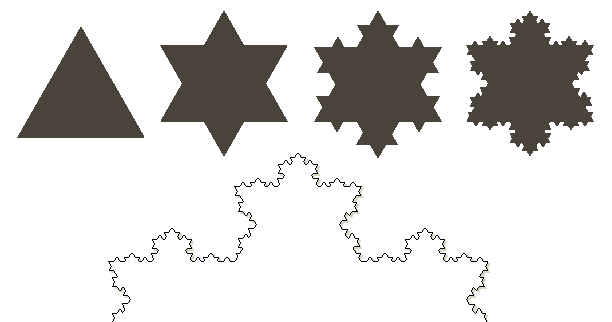
Construction of a Fractal Snowflake
A Koch snowflake is constructed by making progressive additions to a simple triangle. The additions are made by dividing the equilateral triangle’s sides into thirds, then creating a new triangle on each middle third. Thus, each frame shows more complexity, but every new triangle in the design looks exactly like the initial one. This reflection of the larger design in its smaller details is characteristic of all fractals.
iii. Fractal shapes occur everywhere in nature: a head of broccoli, a leaf, a snowflake—almost any natural form. See http://math.bu.edu/DYSYS/explorer/index.html.
iv. Mandelbrot’s discovery changed computer graphics—by using fractal formulas, graphic engines could create natural-looking virtual landscapes. More importantly, fractal formulas can account for variations in other natural patterns such as economic markets and weather patterns.
Mandelbrot Set
Polish-born French mathematician Benoit Mandelbrot coined the term “fractal” to describe complex geometric shapes that, when magnified, continue to resemble the shape’s larger structure. This property, in which the pattern of the whole repeats itself on smaller and smaller scales, is called self similarity. The fractal shown here, called the Mandelbrot set, is the graphical representation of a mathematical function.
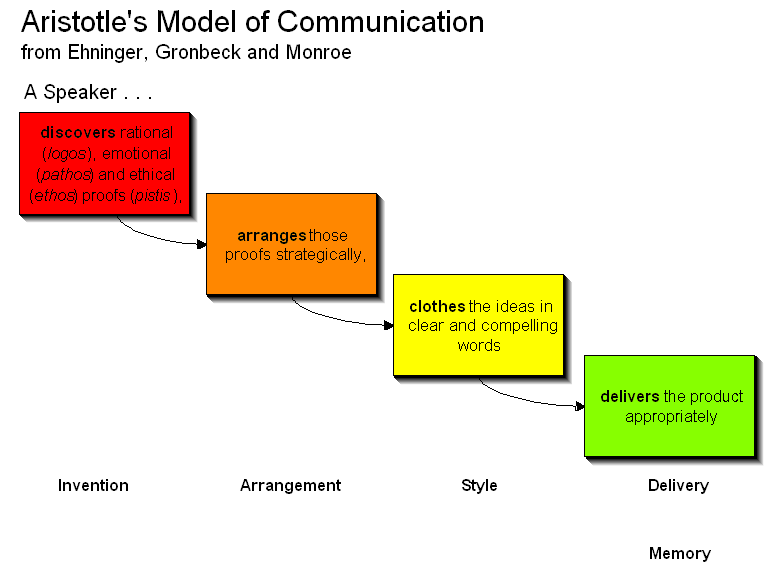
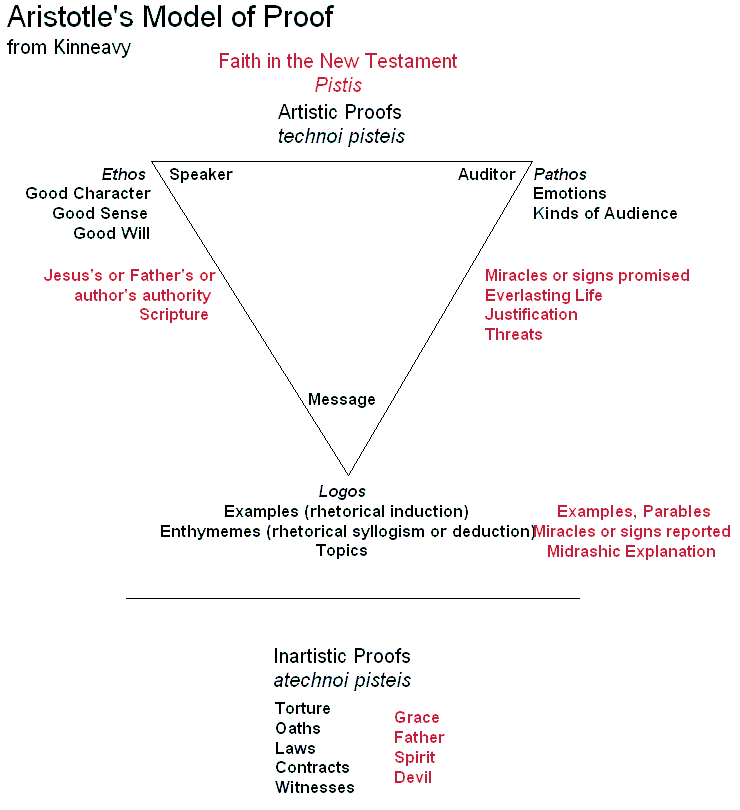
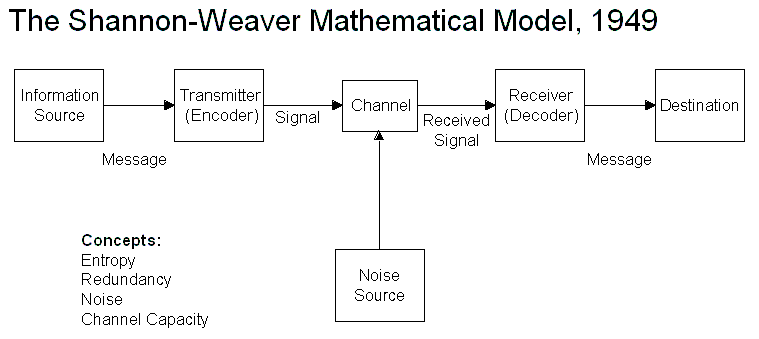
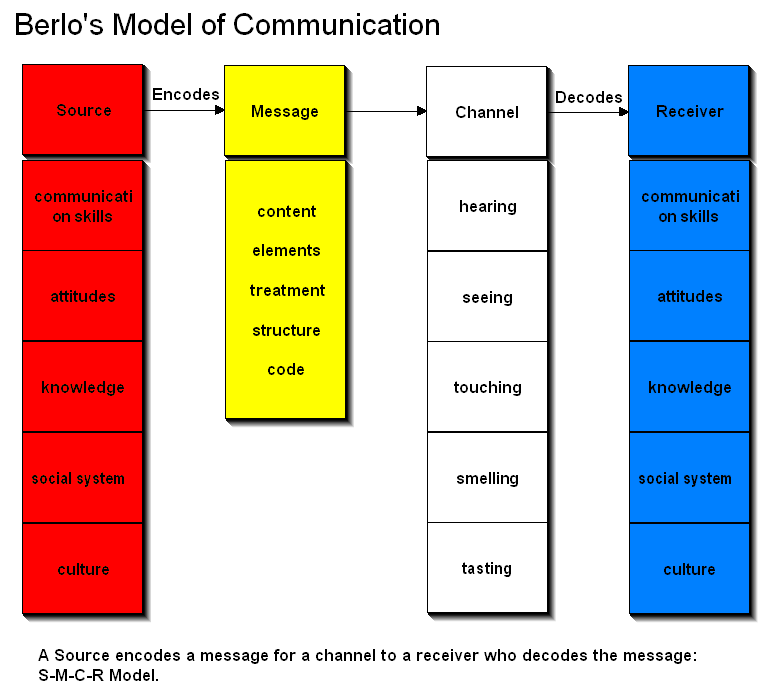
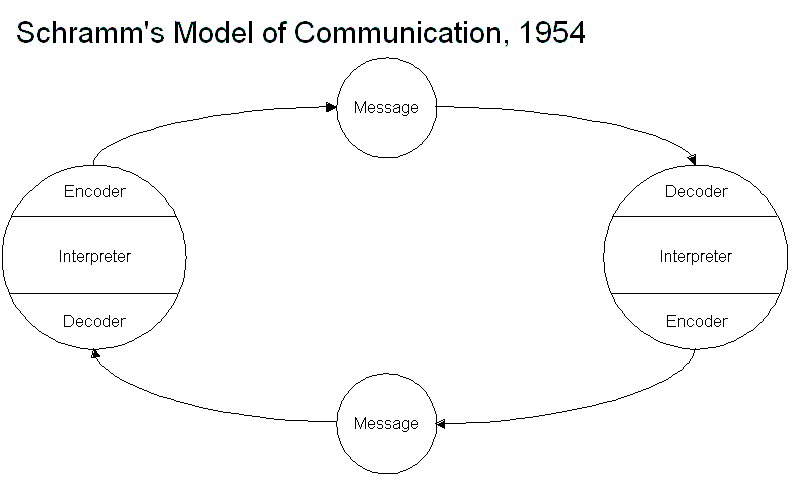
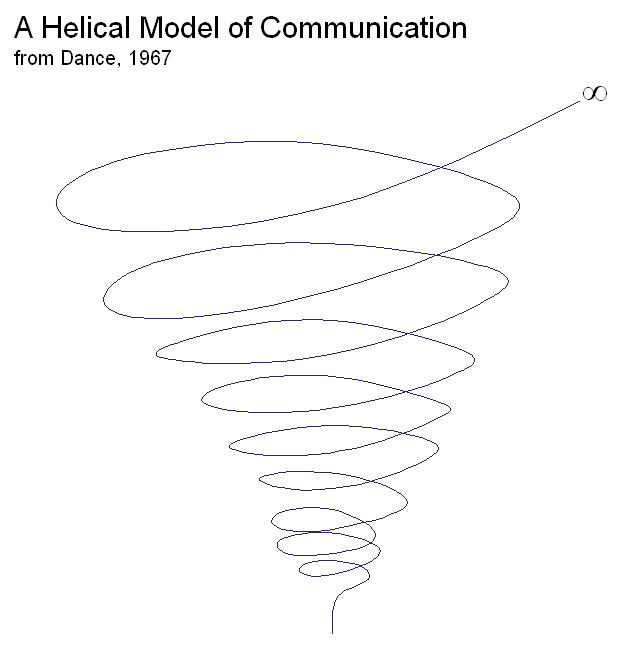
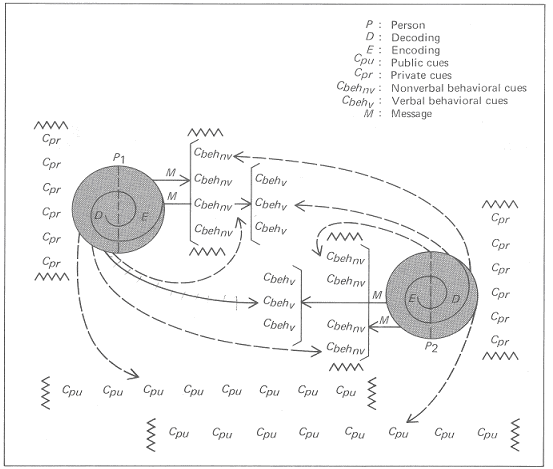

No comments:
Post a Comment